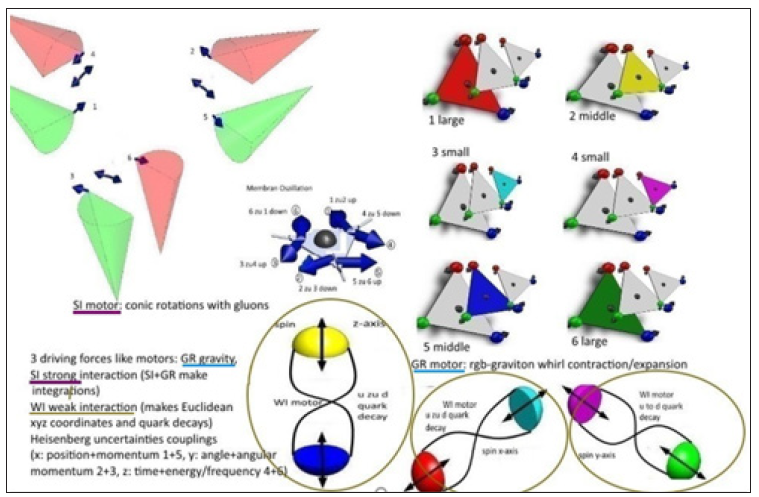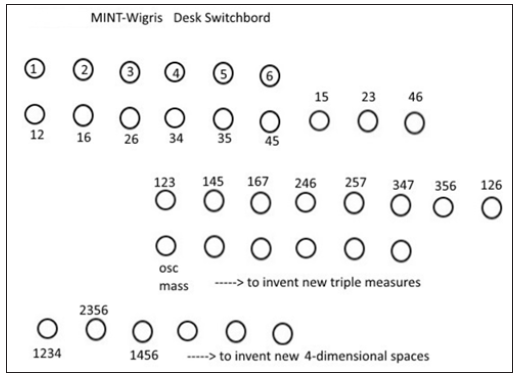Impact Factor : 0.548
- NLM ID: 101723284
- OCoLC: 999826537
- LCCN: 2017202541
Gudrun Kalmbach HE*
Received: July 11, 2018; Published: July 19, 2018
*Corresponding author: Gudrun Kalmbach HE, PF 1533, D-86818 Bad Woerishofen, Germany
DOI: 10.26717/BJSTR.2018.07.001448
In Physics today it is accepted that the findings on the particles properties require that the old 4-dimensional vector spacetime description is not adequate. In contrary to the known string theory I work with octonians and double up the spacetime dimensions as also done for the physics phase space. I describe in [1] deuteron states through the known properties for three of the three basic four basic interactions or forces in physics. Field quantum’s for this are the weak bosons of the weak interaction, gluons of the strong interaction, rgb-graviton whirls (newly added) for a gravitational action, phonos for heat transfer. Stochastically can a six-fold energy exchange between a deuterons inner space and its environment occur. This is more complicated as in biology or chemistry. Using only one main factor: biology is based on DNAs and evolution of systems in time. Chemistry is based on the electron number in atoms shells which is also the proton number of atomic kernels AK. The neutron content of AKs may also have a chemical influence. Now physics treats its systems P as a portion of the universe under investigation. This means for a mathematician that they accept what experiments tell them.
This is the first mistake: quantum measurements mean that a measured system P has to be prepared before the measurement like a patient before a medical operation. Then the measuring apparatus A is applied to P. It is known that P can then change its state by being measured. The best-known example is the spin measurement in the Stern-Gerlach experiment. My octonian view is that quantum measurements are also done without such an external A. The new measures are Gleason frame GF triples like the three spin coordinates in S = (sx,sy,sz) in the Euclidean xyz-space. In octonian coordinates, named 0,1,...,7 these are 123 and 4 is for the time coordinate. As listed in [1,2] beside the space measuring apparatus everyone experience seven octonian GF: 145 is for the electrical induction. This is also my model for new measuring systems A: an electrical charged loop is rotating in a transversal crossing magnetic field and as measured output the induction vector is generated, orthogonal to the magnetic momentum and a loop.
For the observed neutrino oscillation, I suggested a mass triple GF 247: instead of the spin vector length as scalar, the three possible masses for the e, mu, tau neutrinos are used with a common weight which for every GF can be measured like the spin length |S|. Such mass triples may also be useful for quark systems. All fermion series are provided with 6 possible masses. Mathematically I treat this with the unused symmetry S4 in physics, the permutations of four elements. My second claim is that not only the use of quantum measurements has to be extended by octonian GF’s, but also the range of symmetries of the standard model: it can be extended for gravity. Added are in [1,3] the symmetry of Moebius transformations MT on a 2-dimensional Riemannian sphere S2. Concerning the symmetry S4, one needs three reference points, called 0,1,∞. In a central projection, a harmonic middle point can be constructed which is taken as a variable complex number z. Then use a multivalued function for measuring fermionic masses, the complex cross ratio. The S4 gives six MTs which can be listed as complex fractions z, 1/z, 1-z, 1/(1-z), z/(1-z), (1-z)/z. In octonians I use a MT of order 6 related to the general relativistic factor of Einstein’s Schwarzschild metric in the form (r-1)/r, r radius.
This acts for a Higgs field as decay operator. I call it a Higgs compass with a needle which can only change in discrete steps using the sixth roots of unity. Its six-fold numerical values appear not only for fermion masses but for the six color charges of QCD, for the six electrical charges and in my model also for six energies. Reducing physics to one main factor: these six energies have to be studied in experiments. Biological version: use the Feigenbaum equation for generating them in a bifurcation from the octonian e0 vector, set them on six energy coordinates: 1 (123 triple) is for electrical charge and potential, 2 (246) is for heat and entropy in a volume, 3 (347) is for rotational energy with the GF tirple L = rxp, L angular momentum, p = mv momentum; 4 (145) is for time and magnetic (momentum), 5 for barycentrical mass, 6 for frequencies. The 7th octonian coordinate (167) is rolled as a U (1) circle for light and exponential or periodic functions.
For including gravity in an extension of the standard model also the geometry has to be extended. Einstein added in his special relativity SR the affine Minkowski metric. This must be projective extended. The QCD geometry is a toroidal product S3xS5 fo a 3- with a 5-dimensional sphere. S5 can be normed to the complex 2-dimensional space CP2 with boundary S2. It is taken as inner space for nucleons and deuteron. Mathematically I describe then the exchange of field quantums inside between the observed three or six quarks in the prism Figure 1. It is possible to make a switchboard where young researchers can list which action or superposition of actions shall take place. This changes the state of deuteron. The CP2 projection is gravity GR bound. My rgb-gravitons whirls are inside CP2 as neutral color charge red, green, blue whirls (superposition). They fix three observable points for quarks. For the switchboard is important that the MT symmetry of the quark triangle generates a strong interaction SI rotor. There are three driving rotors (acting like motors): the SI rotor which is also for the energy exchange of deuteron with its environment, carrying the six color charge caps in the hedgehog figure; the weak interaction WI rotor is generating Euclidean spin co-ordinates while the SI rotor (GF triple 356) generates barycentrical coordinates for mass barycenter’s (GF triple 257) (Figures 1-4).
Figure 3: rgb-graviton whirls at left, at right deuteron contraction/expansion of radius, middle part fixing the three quark barycenters, below this: WI exchange of isospin, next figures below: the hedgehog, the six roll mill, the switchboard, Higgs compass, wheel.

The GR action acts in addition as a deuteron radius S2 contraction together with a heat expansion. This has in addition to the rgb-graviton whirls an GR/EM potential motor as third driving force (EM: electromagnetism). I mention that a unification of GR and EM fields was published by E Schmutzer [4]. His common field can come from the former S5 sphere of the QCD geometry. GR and SI are not independent but overlap in the nuclear range geometrically. The field quantums act on deuteron states which means that the three driving motors GR/EM, SI, WI generate in the model of [1] a finite number of possible states; SI uses gluon exchanges and the SI rotor, WI uses for deuteron kernels the inner u-quark decay by a W+ boson into a d-quark where the W+ is absorbed (in pairing the six quarks) by an oppositely (on the x-, y- or z-axis) located d-quark which generates an isospin exchange between the deuterons proton and neutron, and GR/EM uses a GR rgb-graviton whirl or heat energy exchange between deuterons inner CP2 space and its environment, and changes the deutron Bohr-radius in three values small-middle-large (Figures 5-8).
Figure 6: 1-6 energies, 12, 16, 26, 34, 35, 45 gluons. 15, 23, 46 W+ bosons, then GF octonian measures.

For biology or medical considerations, the model has the energy bifurcation as biological Feigenbaum equation (Pascal ellipse below), the hedgehog for vectorial source/sink polar caps energy exchange between an inner part of a system with its environment, for chemistry a tool chest with a switchboard macroscopical constructible prism model like those for molecules. Parts of the model are constructed for a three motors driven flow called six roll mills [4], for the WI motor as wheel, for the SI rotor and the potential generated GR/EM contraction/expansion can be demonstrated by a possible S2 projection in a plane E where an MT changes the distance between S2 and E [5]. From [6] is taken that the WI motor runs with a different speed than the SI+POT motors. For getting a common group speed for the nucleons inner dynmaics it is assumed that the Euclidean WI coordinates are in special relativistic SR motion against the SI/GR coordinates’. The SR speed can come from the observed mass rescaling of the u-quarks when measured as GF weight in WI coordinates. There are 5 videos for the model’s inner dynamics available.


